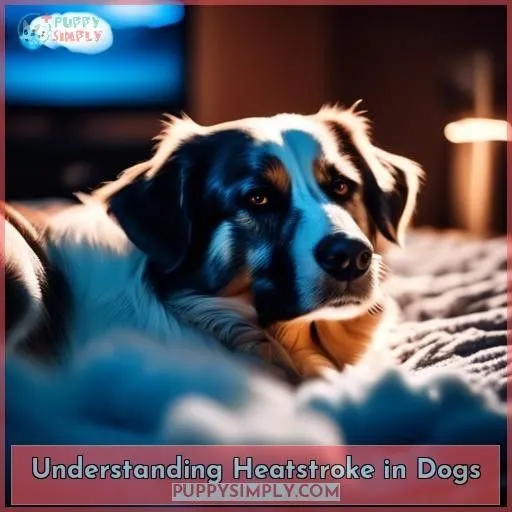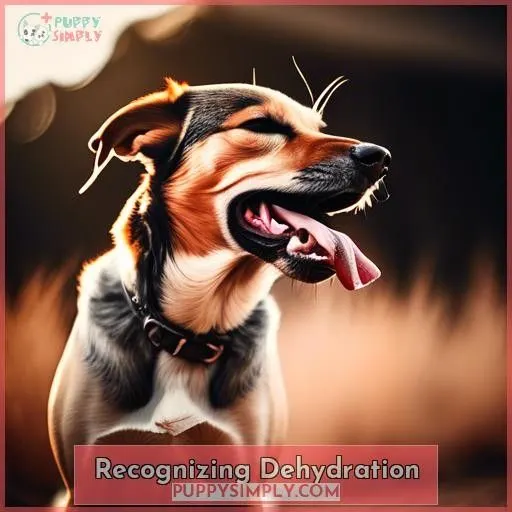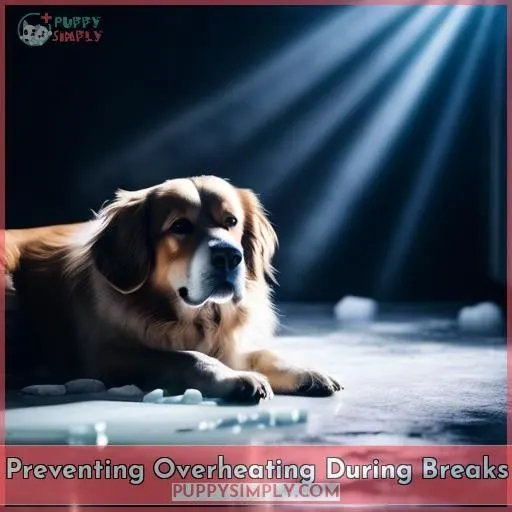This site is supported by our readers. We may earn a commission, at no cost to you, if you purchase through links.
Maintaining your dog’s coolness during summer is essential to avoid heatstroke and dehydration. Indications of heatstroke include excessive panting, drooling, bright red gums, shaking, and weakness.
To prevent heatstroke, guarantee your dog remains hydrated by providing 1/2 to 1 oz of water per pound of body weight daily. Monitor water intake, use ice cubes after exercise, and consider refillable water dispensers.
Exercise your dog early in the morning or late in the evening to bypass the midday heat. Use dog boots on hot surfaces and always carry water on walks. Frozen treats like homemade pupsicles, safe frozen fruits, and veggies, and frozen Kongs can provide relief.
Shaded areas and water play are fundamental for cooling down. Never leave your dog in a hot car, and always carry water and a first aid kit on road trips.
Recognize signs of dehydration, such as dry nose, lethargy, and loss of appetite, and prevent it by providing ample water and shade. If your dog shows signs of overheating, provide a cool area to rest and offer water.
By following these tips, you can ensure your dog stays safe and comfortable during the summer months.
Table Of Contents
Key Takeaways
- Recognize signs of heatstroke, such as excessive panting, drooling, bright red gums, shaking, and weakness, and prevent it by ensuring your dog remains hydrated with 1/2 to 1 oz of water per pound of body weight daily.
- Exercise your dog early in the morning or late in the evening to bypass the midday heat, and use dog boots on hot surfaces and always carry water on walks.
- Provide relief with frozen treats like homemade pupsicles, safe frozen fruits and vegetables, and frozen Kongs, and create shaded areas and water play for cooling down.
- Never leave your dog in a hot car, and always carry water and a first aid kit on road trips. Recognize signs of dehydration, such as dry nose, lethargy, and loss of appetite, and prevent it by providing ample water and shade.
Understanding Heatstroke in Dogs
Understanding the indications of heatstroke in dogs is essential for their protection during the warm summer months. If you observe excessive panting, salivating, or sluggishness, it’s crucial to take immediate action to avoid severe health problems.
Signs of Heatstroke
Understanding Heatstroke in Dogs
Heatstroke is a grave condition that can afflict dogs, particularly during sweltering weather. It manifests when a dog’s internal temperature escalates to perilous levels, potentially culminating in organ dysfunction or even demise. Certain dogs have a higher susceptibility to heatstroke, so it’s imperative to be cognizant of the predisposing factors and manifestations to avert this potentially life-threatening condition.
- Excessive panting
- Drooling
- Bright red gums
- Shaking
- Weakness
- Confusion
- Vomiting
- Diarrhea
- Seizures
If your dog exhibits any of these symptoms, it’s paramount to intervene promptly and seek veterinary assistance.
Risk Factors
- Obese dogs
- Flat-faced dogs (brachycephalic breeds)
- Energetic dogs
- Senior dogs
- Larger dogs (over 50kg)
Preventing Heatstroke
To safeguard your dog from overheating and ensure their well-being during hot weather, consider the following measures:
- Exercise early morning or evening.
- Carry water and attach a leash to a walking harness.
- Ensure dogs wear collars.
- Refrain from exercising sick or dehydrated dogs.
- Provide a water bowl in the shade.
- Create shaded areas.
- Offer a paddling pool or hose play.
- Never leave dogs unattended in cars.
- Secure a safe spot in the car.
- Make regular stops and provide cold water.
Immediate Actions to Take
Recognizing symptoms of heatstroke in your furry friend is just the tip of the iceberg. For immediate first aid, think cool thoughts and act fast—move them to a shady spot and apply cooling techniques like damp towels.
Heat safety isn’t just a summer fling; it’s a lifelong commitment.
Hydration is Key
Ensuring your dog’s hydration is paramount during the hot summer months, as their water needs can drastically increase. You’ll need to calculate their daily intake and adhere to optimal practices to avert dehydration and heat-related issues.
Calculating Your Dog’s Water Needs
Maintaining your dog’s cool during the summer months is critical, especially since they’re more vulnerable to heatstroke than humans. To make sure your dog stays hydrated and comfortable, it’s important to understand their water requirements and provide them with plenty of water access. Here are some tips to help you calculate your dog’s water needs:
- Estimate your dog’s water needs: A general guideline is that dogs need around 1/2 to 1 oz of water per pound of body weight daily. For example, a 10-pound dog should drink about 10 fluid ounces per day, while a 100-pound dog should drink roughly 100 fluid ounces in a day.
- Consider diet: Dogs who eat only dry food will need more water than those eating wet food or a homemade diet, as dry food has less moisture content.
- Factor in exercise and weather: Dogs need more water when exercising or during hot weather.
- Monitor health conditions: Certain medical issues, such as kidney disease, diabetes, or medications, may increase your dog’s thirst and water intake.
Best Practices for Water Intake
Keeping your dog hydrated is essential in the summer heat. Dogs need 1/2 to 1 oz of water per pound of body weight daily. Use ice cubes with little water after exercise to prevent bloat, and refillable water dispensers for constant access.
Wash water bowls every other day to prevent bacteria buildup. Dogs require more water during exercise in warm temperatures. Offer water every 15-20 minutes during walks and play, and monitor hydration levels.
The Right Time for Exercise
To safeguard your dog’s well-being during summer, it’s crucial to refrain from exercising them during the warmest periods of the day, typically around midday. Instead, choose early morning or late evening walks when the temperature is more moderate.
Additionally, be aware of hot outdoor surfaces like asphalt and concrete, which can cause burns on a dog’s paw pads. Take breaks between exercise sessions and provide a shaded area where your dog can relax.
By adhering to these guidelines, you can guarantee your dog’s safety and comfort while still ensuring they receive the necessary exercise.
Avoiding the Midday Heat
To keep your dog cool during summer, avoid exercising them during the hottest part of the day. Here are some tips:
- Avoid midday sun: The sun is at its peak between 10 am and 4 pm. Exercise your dog before or after these hours.
- Use dog boots: Protect their paws from hot pavements. Check the temperature with your hand before walking.
- Monitor hydration: Make certain your dog has access to fresh, cold water at all times.
- Prepare for road trips: Make regular stops, provide cool water, and use air conditioning.
- Stay cool together: Engage in water activities or create shaded areas in your yard.
Safe Exercise Practices
Maintaining your dog’s comfort and well-being during summer walks is essential to prevent heatstroke. Here are some prudent exercise practices to adopt:
- Select the optimal time: Exercise your dog during cooler hours, such as early morning or dusk, to bypass the hottest parts of the day.
- Consider breed-specific precautions: Breeds with shortened snouts, such as boxers, pugs, and bulldogs, face difficulty breathing in extreme heat, so avoid strenuous running or hiking when temperatures exceed 60 degrees.
- Monitor your dog’s unique factors: Senior dogs, overweight dogs, and dogs with dense fur are more vulnerable to heat-related ailments, so adjust your exercise routine as necessary.
- Observe for warning signs: Be vigilant for excessive panting, sluggishness, drooling, disorientation, and vomiting, which may indicate advanced heatstroke.
- Maintain hydration: Ensure your dog has access to fresh, cool water at all times.
- Utilize cooling vests: If your dog is prone to overheating quickly, consider using cooling vests or other cooling gear to aid in regulating their body temperature.
- Exercise in water: Swimming is a low-impact exercise that burns calories twice as fast and keeps dogs cool without the risk of overheating.
Frozen Treats for Relief
In the sweltering summer heat, you can offer your dog relief with homemade pupsicles and safe frozen fruits and veggies. These treats not only provide a cooling effect but also hydrate and entertain your pet during the warmer months.
Homemade Pupsicles
- Create a Pupsicle Bar: Arrange a variety of ingredients like yogurt, fruit, and ice cubes on a tray.
- Mix and Match: Combine ingredients to create unique flavors and textures.
- Freeze and Serve: Freeze the mixture in a dog-safe mold, then serve as a delightful treat on hot days.
Safe Frozen Fruits and Veggies
Frozen fruits and veggies make excellent, safe, and healthy treats for your dog. They can be frozen alone or mixed with other ingredients to create homemade pupsicles. Here’s a table of safe fruits and veggies for your dog:
| Fruits | Veggies |
|---|---|
| Apples | Carrots |
| Bananas | Cucumbers |
| Blueberries | Green beans |
| Mango | Pumpkin |
| Pineapple | Sweet potatoes |
Remember to avoid grapes, onions, and garlic, as they’re toxic to dogs. Frozen Kongs are also a great option for keeping your dog cool and entertained.
Shade and Water Play
Creating shaded areas in your yard provides a cool retreat for your dog during the hot summer months. Engaging in fun water activities like swimming or playing with a hose can greatly help in keeping your dog cool and hydrated.
Setting Up Shaded Areas
To create shaded areas for your furry friend, consider using patio umbrellas, canopy covers, or dog shade covers. If you have a dog door, make sure it leads to a shady spot.
Trees also provide natural shade, but remember to check for potential hazards like poisonous plants or insects.
By setting up these shaded spaces, you’re ensuring your dog stays cool and comfortable during those hot summer days.
Fun Water Activities
Keep your furry friend cool and entertained this summer with fun water activities! Engage in water games like running through sprinklers or swimming, and provide water toys such as Kongs, tug toys, and chew toys for cooling relief.
Don’t forget about water parks and fountains for a day of splashing fun. Always make certain water safety is taken care of, and remember, wet dogs are cooler dogs.
Vehicle Safety Measures
Keeping your dog cool in the car during summer is essential. Never leave your dog unattended in a parked vehicle, as temperatures can rise quickly, leading to heatstroke. When traveling, make sure your dog has access to water, and take regular breaks to prevent overheating.
Never Leave Dogs in Cars
Never leave your dog alone in a car on hot days. The temperature inside a car can rise rapidly, even on mild days, and can lead to heatstroke, which can be fatal for dogs. Always make sure your dog is safe and comfortable when traveling by car. Here are some tips to keep your dog cool and safe in the car:
- Emergency Preparedness: Be aware of your state’s laws regarding animals left in vehicles. In some states, it’s illegal to leave an animal unattended in a vehicle, and Good Samaritan laws allow anyone to rescue an animal if they follow certain steps.
- Heatstroke Prevention: If you see a dog left in a hot car, take down the car’s color, model, make, and license plate number. Have the owner paged in the nearest buildings or call local humane authorities or police. If the situation appears to be an emergency, take steps to remove the dog from the car and wait for authorities to arrive.
- Car Safety: Install window tinting to reduce sun exposure and protect your pet from harmful UV rays. This can help keep your car cooler and provide a more comfortable environment for your dog.
- Pet Insurance: Consider getting pet insurance to cover any potential health issues related to heatstroke or other summer dangers.
Preparing for Road Trips
Preparing for a road trip with your pet involves more than just packing their favorite toys. To guarantee a safe and comfortable journey, follow these safety precautions:
- Car Ventilation: Keep your car well-ventilated by opening windows or using air conditioning.
- Emergency Supplies: Pack a first aid kit, water, and food for your pet in case of unexpected stops.
- Travel Anxiety: Train your pet for car travel to reduce anxiety and make the journey more enjoyable.
- Friendly Stops: Plan for friendly stops along the way, where your pet can stretch, relieve themselves, and socialize.
Recognizing Dehydration
Recognizing dehydration in dogs is essential for their well-being, especially during hot summer months. Symptoms of dehydration include excessive panting, loss of elasticity in the skin, dry gums and mucous membranes, sunken eyes, lethargy, and loss of appetite.
To prevent dehydration, make sure your dog has constant access to clean water, especially when they’re outside or engaging in strenuous activities. Additionally, monitor your dog’s water intake and adjust it according to their needs, which may increase during hot weather or periods of intense exercise.
If you suspect your dog is dehydrated, offer them small amounts of water and consult with your veterinarian.
Symptoms of Dehydration
Recognizing dehydration in dogs is essential for heatstroke prevention. Symptoms of dehydration include excessive panting, lethargy, dry mouth, and sunken eyes. Electrolyte imbalance can also occur due to inadequate water intake. Monitor your dog’s hydration levels by checking their water intake and adjusting their diet if needed.
Preventing Dehydration
To prevent dehydration in your furry friend, make sure they drink enough water. Aim for 1/2 to 1 oz of water per pound of body weight daily. Factors like size, food, exercise, weather, and medications can affect water intake. Use ice cubes after exercise to prevent bloat and provide constant water access with a refillable dispenser.
Wash water bowls every other day to prevent bacteria buildup. Take breaks every 15-20 minutes during walks and general play, and every 10 minutes during strenuous activities. Signs of overheating include excessive panting, whimpering, slower pace, and frequent lying down.
Preventing Overheating During Breaks
During breaks, it’s essential to notice when your dog needs a respite. Signs include excessive panting, whimpering, slower pace, and frequent lying down. During these breaks, offer water, shade, and snacks. Inspect your dog’s paws, fur, and overall well-being.
Signs Your Dog Needs a Break
When your dog is panting excessively, it’s a clear sign they need a break. Monitor the frequency and duration of their panting, as well as body language cues like drooping ears and a lowered tail. These signs indicate your dog is overheating.
By recognizing these signs, you can prevent heatstroke and make sure your dog stays cool and comfortable during breaks.
What to Do During Breaks
Keeping Your Dog Cool During Breaks: Tips for Preventing Overheating
During breaks, it’s important to make sure your dog stays cool and comfortable. Here are some tips to help you do just that:
- Rest Frequencies: Let your dog rest often, especially during strenuous activities like fetch, tug, hiking, or running. Take breaks every 15-20 minutes during walks and general play, and every 10 minutes during intense activities.
- Shade Accessibility: Provide shade in the yard using patio umbrellas, canopy covers, dog shade covers, trees, or dog doors. Find shaded areas on hikes or bring an umbrella for extra protection.
- Treat Variety: Offer a variety of treats to help your dog cool down. Frozen treats like pupsicles, frozen fruits and veggies, and frozen Kongs can provide relief. Frozen toys, including Kongs, tug toys, and chew toys, can also offer cooling relief.
- Safe Water Access: Make sure your dog has access to cool water during breaks. Use a refillable water dispenser for constant water access and wash water bowls every other day to prevent bacteria buildup.
- Health Monitoring: Check your dog’s paws, fur, and overall condition during breaks. Signs of overheating include excessive panting, whimpering, slower pace, and frequent lying down. Monitor your dog’s body temperature using a digital thermometer and cool them down by squirting with water or rinsing their mouth if necessary.
Frequently Asked Questions (FAQs)
What are the signs of heatstroke in dogs?
Signs of heatstroke in dogs include heavy panting, excessive drooling, lethargy, dizziness, and difficulty walking. In severe cases, dogs may collapse, have seizures, or become comatose. If you suspect your dog has heatstroke, move them to a cool area, offer water, and contact a veterinarian immediately.
How often should I provide water to my dog during exercise in hot weather?
To make sure your dog stays hydrated during exercise in hot weather, provide water every 15-20 minutes.
Can I use ice cubes to prevent bloat in dogs?
Yes, using ice cubes can help prevent bloat in dogs. However, it’s essential to supervise your dog while they’re eating ice cubes to prevent choking or breaking teeth. If your dog is prone to bloating, it may be best to avoid giving them ice cubes, as they can set the stage for bloat. Instead, offer small amounts of water at regular intervals to encourage slower drinking and reduce the risk of bloat.
What is the best way to hydrate dogs during long car journeys?
To keep your dog hydrated during long car journeys, follow these tips:
- Bring the right equipment: Use a container designed for holding your dog’s water, such as the Highwave AutoDogMug, which provides features to prevent spills, keep the water cold, and make the container more portable.
- Use the right water: Avoid tap water from convenience stores or natural water sources that may contain bacteria harmful to your dog’s gut. Instead, use filtered water from a high-quality dog hydration equipment like the AutoDogMug.
- Stop for water often: Take regular breaks every 60-90 minutes to allow your dog to drink water. Use a trigger phrase like are you thirsty? to encourage your dog to drink.
- Give ice cubes as treats: Some dogs love ice cubes, which can help keep them hydrated during breaks.
- Moisten dry food: Add a sprinkle of water to your pet’s usual dry food to increase its moisture content.
- Mix in chicken stock: If your dog is reluctant to drink water in the car, mix a little bit of chicken stock with their water to make it more enticing.
- Offer wet food: Wet food can contain up to 80% more moisture than dry food, which can help keep your dog hydrated.
- Acclimate your pet to its crate: This is the single-most important thing you can do to reduce your pet’s stress level during travel.
How can I make sure my dog does not overheat during breaks?
Make sure your dog’s rest periods are in shaded areas with access to fresh water. Provide a cooling bed or mat and be on the lookout for signs of overheating such as excessive panting or sluggishness.
Conclusion
As summer’s heat intensifies, keeping dogs cool becomes paramount. By recognizing heatstroke signs and guaranteeing proper hydration, you’re safeguarding your furry friend’s health.
Opt for cool morning or evening walks, and delight them with frozen treats. Always provide shade and water play to combat the heat.















